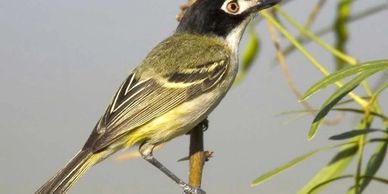Krause Ranch Endangered Fauna
Black-capped Vireo (Vireo Atricapilla)
Golden-cheeked Warbler (Setophaga Chrysoparia)
Golden-cheeked Warbler (Setophaga Chrysoparia)

Flitting about actively in the oak scrub, often hanging upside down momentarily, the little Black-cap is our most distinctive vireo. It is also the rarest, nesting only locally in Texas and Oklahoma. Its eggs take an unfortunately long time to hatch; cowbird eggs, laid in the same nests, usually hatch first, so that the vireos raise only young cowbirds. Without some kind of control of cowbird numbers, the vireo may face extinction.
Golden-cheeked Warbler (Setophaga Chrysoparia)
Golden-cheeked Warbler (Setophaga Chrysoparia)
Golden-cheeked Warbler (Setophaga Chrysoparia)

This beautiful bird is a central Texas specialty, nesting nowhere else in the world. It returns early in spring; by the end of March, males can be found singing from the tops of junipers on arid slopes in the hill country. Its total range and population are small, and recently it has faced a double threat: its habitat is disappearing as the area becomes more developed, and where it does still breed, cowbirds often lay their eggs in its nest.
Golden Eagle (Aquila Chrysaetos)
Golden-cheeked Warbler (Setophaga Chrysoparia)
Zone-tailed Hawk (Buteo Albonotatus)

This magnificent bird is widespread in the wilder country of North America, Europe, and Asia. About the same size as the Bald Eagle, the Golden is less of a scavenger and more of a predator, regularly taking prey up to the size of foxes and cranes. The Golden Eagle was important to many Native American tribes, who admired the eagle's courage and strength, and who ascribed mystical powers to the bird and even to its feathers.
Zone-tailed Hawk (Buteo Albonotatus)
Zone-tailed Hawk (Buteo Albonotatus)
Zone-tailed Hawk (Buteo Albonotatus)

In breeding season, pairs may circle high in air, calling. In another display, bird flaps to high elevation while calling and then dives steeply, almost to ground. Nest site is typically in tall tree such as cottonwood or pine, along river or near cliffs; tree is often somewhat isolated and is usually among the largest in the vicinity. Nest is usually more than 30' above ground, up to 100' or higher. Sometimes nests on cliff ledges. Nest is a bulky platform of sticks, lined with green leafy twigs. Same nest site may be used for many years.
Rock Rattlesnake (Crotalus Lepidus)
Zone-tailed Hawk (Buteo Albonotatus)
Rock Rattlesnake (Crotalus Lepidus)

Small, slender. Bluish/gray-tan with brownish crossbands across back. Keeled scales in rows of 23. Spotting on back may form second set of crossbands. In the United States, Crotalus lepidus is found only in the rocky mountains and hills of southern Arizona, New Mexico, and Texas. The distributional range of C. lepidus includes two additional subspecies in Mexico, extending well into the interior of the country as far south as the mountains of Zacatecas.
Copyright © 2017 Krause Ranch - All Rights Reserved.